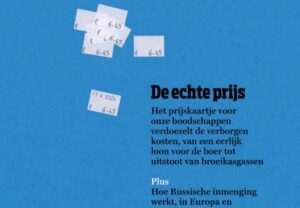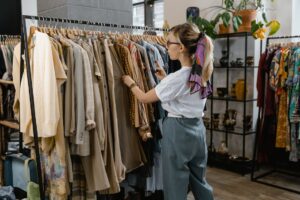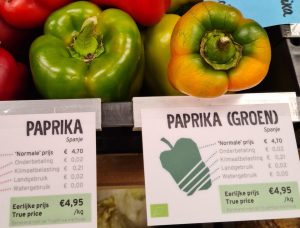True pricing at company restaurants of Vermaat
For three months, 13 company restaurants of Vermaat throughout the Netherlands will pilot true pricing. Visitors will be able to see and voluntarily pay the true price of 3 products. It will help Vermaat to gain more experience with true pricing and to determine how true pricing can add most value to its company restaurants. This pilot helps Vermaat in their long-term ambition to adopt true pricing.
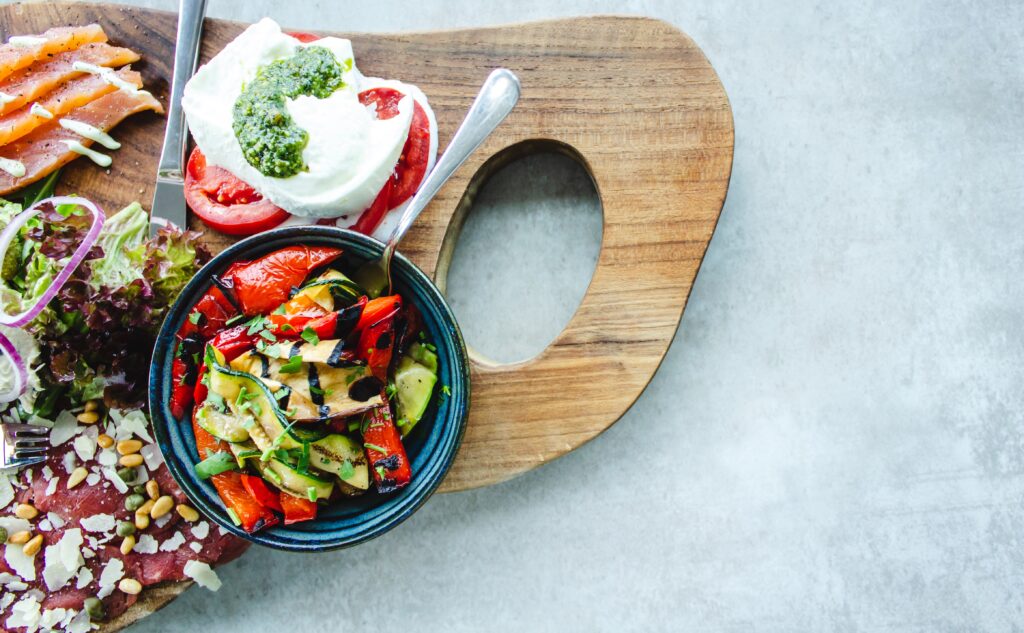
About the project
Vermaat is determined to contribute to a sustainable future and works hard to reduce its footprint, minimize food waste and waste, and contribute to the protein transition. They see true pricing as a tool to achieve their sustainability goals. To take a next step in the field of true pricing, Vermaat, together with organic supermarket De Aanzet, the University of Wageningen and various partners (see below), is carrying out a 3-month pilot project in 13 company restaurants, from September to December 2022. The aim of the pilot is to test true pricing (which has been embraced by organic supermarket De Aanzet since 2020) among a wide and varied audience. In addition, it is being investigated how true pricing can be implemented most efficiently. For the pilot we estimated the true price of 3 popular products: a boiled egg, croissant and glass of skimmed milk. On this page you will find all relevant information about the calculations. This page is intended for visitors of the company restaurants that participate and other interested parties. This research was made possible by the Dutch Ministry of Agriculture, Nature and Food quality, Vermaat, De Aanzet, the University of Wageningen and True Price.


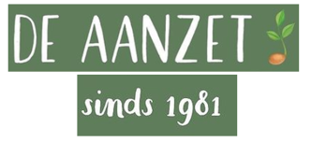

Products
In this project, the true price gap of three SKU’s (eggs, milk, and croissants) have been estimated. These products are popular in the company restaurants, appealing to consumers, and relevant from a true price perspective. The selection is aligned with the organizations involved.

Glass of Semi-Skimmed Milk
Ingredients: Milk (100%)
Origin: The Netherlands
Quantity: 150ml

Hard Boiled Egg
Ingredients: Egg (100%)
Origin: The Netherlands
Quantity: 58gr

Butter Croissant
Ingredients: Wheat flower (58%), sugar (9%), butter (33%)
Origin: France
Quantity: 60gr
Approach
How did we estimate the true price gaps?
The true price gaps are based on the True Price Method. The scope is based on materiality and feasibility assessments. They cover a substantial part of the complete true price gaps. All scoping considerations have been discussed and aligned with the project partners.

Value Chain Steps
The estimates cover material parts of the value chain per ingredient
- Raw materials for cultivation
- Cultivation (on farm)
- Boiling (eggs) and baking (croissant)
- Transport to and within The Netherlands

Impacts
The estimates cover 8 material social and environmental impacts
- Contribution to climate change
- Water use
- Water pollution
- Land use
- Air pollution
- Use of scarce materials
- Poverty (underpayment and underearning)
- Child labour

Data
The results represent national average true price gaps of the products, based on:
- International footprint databases
- True Price monetizations factors
- Limited primary data
As with all research, the results have limitations. Feel free to check them here.
Results
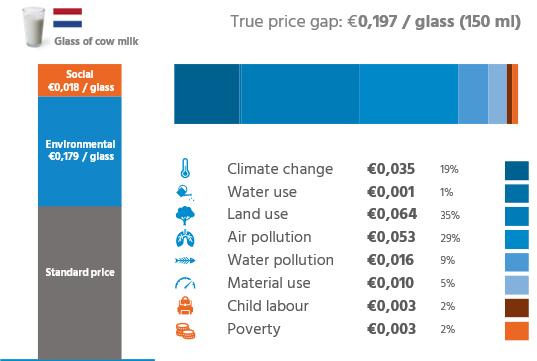
We estimated the true price gap of an average glass of skimmed cow milk (150 ml) produced in the Netherlands. The biggest impacts are land use, air pollution, and contribution to climate change. These are the result of the environmental impact of raising cows and cultivation their feed for the production of milk. The analysis found a small impact for child labour and underpayment, related to the procurement of raw materials for farms. Cooking and transport are relatively small contributors to the true price gap.
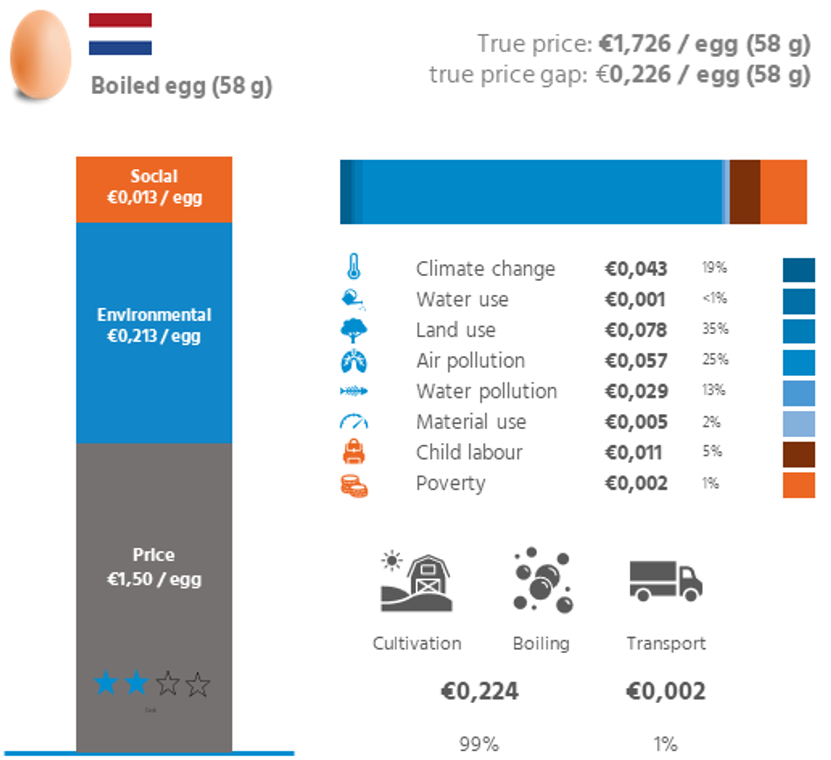

Vermaat and true pricing
Even though we have to deal with price increases due to, for example, COVID-19, the war in Ukraine and scarcity, the True Price of a product is rarely paid. By the true price we mean the selling price including the hidden costs such as environmental damage, CO2 emissions, low wages or in the worst-case child labor. Doesn’t that give a nasty aftertaste? Fortunately, there is a fair solution for people and the planet. Companies can calculate these social and environmental costs using the True Price method. By including the extra costs in the price, a fairer system is created, and sustainable production becomes the norm.
The answer to this question is our starting point for this True Pricing Pilot. Together with the Ministry of Agriculture, True Price, Wageningen University & research, first True Price supermarket De Aanzet, our suppliers and hopefully you as a consumer, we want to get an answer to this question. Our mission is to calculate the true price on all common products at our locations and work towards a fairer food system. A project like True Price suits us well, because health, sustainability and social impact are important themes for Vermaat and OSP.
On Black Friday 2019, organic supermarket De Aanzet started with true prices on fresh products such as vegetables, fruit and bread. This has already yielded about 30,000 euros in hidden costs that we use to reduce the hidden costs of various vegetables – through investing in open-field vegetable farms from which we purchase products. Our aim is to reduce hidden costs to zero within 5 to 10 years for a large number of products, so that customers’ food footprint is greatly reduced. Due to the success, we will also start this autumn with groceries such as rice, nuts, muesli, among others. For De Aanzet, it is important to gain more insights into how we communicate true prices to consumers. Through this project, we hope to gain insights from a broad and diverse group of people on how we can best include consumers in the true price concept to make the world more beautiful and better together.
Good to know...
Review process
The project has followed a carefull and standardised review process. All results, data sources, and insights have been validated by independent impact professionals of True Price and the parties involved.
Limitations of the results
The results are based on secondary data(bases), product averages, and a number of assumptions. Moreover, a number of value chain steps and impacts are not in scope. Therefore, the results do not represent the complete true price gap of the products, nor the true price gap of the specific suppliers of Vermaat, and a limited margin of error should be taken into account. We advice caution and restraint in communicating and using the results to prevent confusion, miscommunication and misinterpretation

